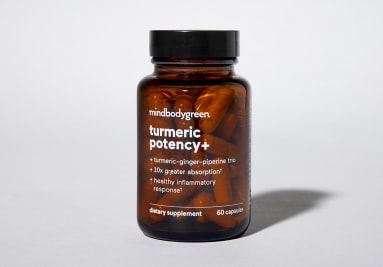How A Quality Turmeric Supplement Can Help Boost Antioxidant Activity



When it comes to the traditional uses of turmeric, physician and Ayurveda expert Avanti Kumar-Singh, M.D., thinks the better question is "What is turmeric not traditionally used for?"
As a first-generation South Asian woman, she recalls fond memories of the golden spice: frequently cooking with it, her mother's healing uses of it, and even her pre-wedding "Vatna" ceremony—a traditional beauty ritual in which a cleansing paste made of chickpea flour, turmeric, and mustard oil was applied to her skin by members of her family.
Ayurveda has used turmeric for thousands of years to strengthen the energy of the body and remedy just about everything, but Western wellness has only recently touched on (i.e., studied) the ranging benefits of this golden spice.
In the past 30 years or so, the health industry has discovered the scientific brilliance of turmeric and one of its most powerful compounds, curcumin.
Of all of turmeric's impressive health traits, one of the herb's most revered benefits is its ability to bolster antioxidant activity. Oxidative stress seems to be one of the toughest problems our bodies face—it's responsible for influencing our DNA and can lead to a number of health concerns down the road if left unchecked.
That's exactly why turmeric's ability to fight free radicals and combat oxidative stress make it loved by so many.*
How turmeric bolsters antioxidant activity.
"Free radicals are responsible for creating a lot of oxidative stress in the body, which can result in various health concerns down the road," shares registered holistic nutritionist and Ayurvedic physician Manjiri Nadkarni, M.D.
Increased antioxidant activity in the body promotes holistic well-being and overall longevity. (After all, whole-body health starts at the cellular level.)
Research has shown curcumin improves systemic markers of oxidative stress, which provides a number of advantages for whole-body health: "The biochemical structure of turmeric allows it to neutralize free radicals and protect the body from oxidative stress,"* says Kumar-Singh.
How mbg's turmeric potency+ promotes cellular resilience.
mbg's daily turmeric supplement, turmeric potency+, is powered by full-spectrum turmeric, ginger, and bio-enhancer piperine from black pepper extract.
You already know how hard turmeric works at kicking free radical butt, but did you know that both ginger and black pepper aid in the fight? Each one delivers its own punch of antioxidant activity in the body and bolsters the activity of the others.*
In preclinical trials, ginger (specifically, 6-gingerol—the most active of the gingerols) has been found to protect lipids from free radical stress and raise antioxidant potential2.*
Piperine is the major bioactive component of black pepper. It's usually paired with turmeric in food and supplements because it enhances the bioavailability of curcumin, thereby significantly improving curcumin's ability to work its magic as an antioxidant.*
What's more, researchers have also identified piperine's ability to combat oxidative stress3 and work as an antioxidant4 on its own.* (Talk about a stellar trio of antioxidant powerhouses.)
How turmeric potency+ enhances curcumin's bioavailability.
Curcumin is notoriously difficult to absorb. But with the right ingredients and a focus on bioavailability, a premium daily turmeric supplement can help enhance the amount of curcuminoids that your body can easily and effectively use.
"Turmeric supplements often include greater concentrations of curcumin, the active compound in turmeric. But curcumin alone is not as absorbable nor as effective as full-spectrum turmeric," says Rachelle Robinett, R.H., herbalist and founder of Pharmakon Supernatural. "So, if you're using a concentrated supplement—which is a great way to get an efficacious dose of the herb—make sure it also includes the full-spectrum turmeric extract and/or some black pepper."
Thanks to a 500-milligram dose of full-spectrum turmeric (as Acumin™) that features the complete turmeric matrix5 delivered in polar-nonpolar-sandwich (PNS) technology6, mbg's turmeric potency+ is 10 times more bioavailable than other regular forms of turmeric supplements.*†
PNS technology places bioactive compounds that aren't water- or fat-soluble (like curcuminoids and gingerols) back into a complete natural matrix, making them more stable, easily absorbed, and bioavailable.* Supporting actors full-spectrum ginger root extract (which also features PNS technology) and bio-enhancer piperine from black pepper extract round out mbg's antioxidant-rich formula for a bioavailable dose of free-radical-fighting power.*
The takeaway.
Ayurveda has used turmeric to combat oxidative stress for a long time (like 4,000 years). Although you can incorporate this ancient herb into your daily life by adding it to your lattes or curry dishes, a supplement is the best way to ensure you're reaping the targeted benefits of this legendary antioxidant.*
With full-spectrum turmeric root and ginger root extracts that utilize PNS technology and bio-enhancer piperine from black pepper extract, mbg's turmeric potency+ ensures optimal bioavailability so none of your turmeric ever goes to waste and it can continue optimizing your whole-body health by neutralizing free radicals.*
† Acumin™ research has demonstrated superior bioavailability, curcuminoid serum response, and stability compared to other common forms of turmeric root extract (e.g., volatile oil, phospholipid/liposomal, and standard 95% curcumin).

Josey Murray is a freelance writer focused on inclusive wellness, joyful movement, mental health, and the like. A graduate of Wellesley College, where she studied English and Creative Writing, her work appears in Women’s Health, Cook & Culture, and more. By expressing her own vulnerability, she writes with warmth and empathy to help readers find self-compassion and true wellness that’s sustainable for body, mind, and planet.
6 Sources
- https://www.ncbi.nlm.nih.gov/pmc/articles/PMC5664031/
- https://pubs.acs.org/doi/abs/10.1021/acsfoodscitech.1c00073
- https://www.tandfonline.com/doi/abs/10.1080/10408390601062054?scroll=top&needAccess=true&journalCode=bfsn20
- https://www.mdpi.com/2076-3417/9/20/4270/htm
- https://www.ncbi.nlm.nih.gov/pmc/articles/PMC6222699/
- https://www.sciencedirect.com/science/article/pii/S0928493117305854?via%3Dihub

